Spanish Paella
This post may contain affiliate links. Read my full disclosure policy.
Paella is a classic Spanish rice dish that combines the best of land and sea. This version, packed with smoky chorizo, shrimp, and mussels, is easier to make than you’d think—and will rival your favorite Spanish restaurant’s version!
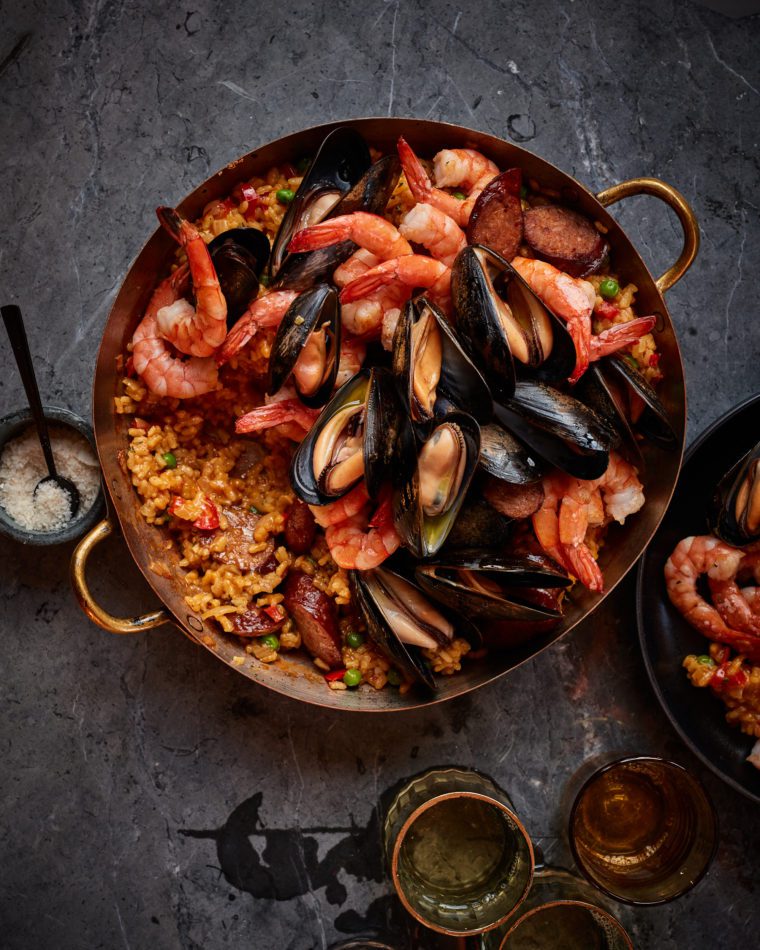
Photo by Johnny Miller (Clarkson Potter, 2021)
Paella is a traditional Valencian dish made from rice, vegetables, meat, and seafood, and flavored with saffron. Pronounced “pie-AY-uh,” it takes its name from the paellera, the wide, shallow pan in which it is traditionally cooked. Paella is one of my family’s favorite dishes to share when we go out for Spanish food, and it’s fun to make for a festive occasion at home, too. I know it seems like a big to-do, and it certainly can be if you add a wide variety of meat and seafood—the original version from Valencia contains snails and rabbit—but I keep it relatively simple here by using only quick-cooking smoked chorizo, shrimp, and mussels.
A paella pan is useful and pretty if you have one, but there is no need to go out and buy one—you can use any large skillet to make paella. This Spanish dish is a feast!
Table of Contents
“This is paella within reach—and it’s fantastic. My husband, 20-year-old son, and teenage daughter all raved…It is totally weeknight-dinner possible, and would be great for a small dinner party.”
What You’ll Need To Make Paella
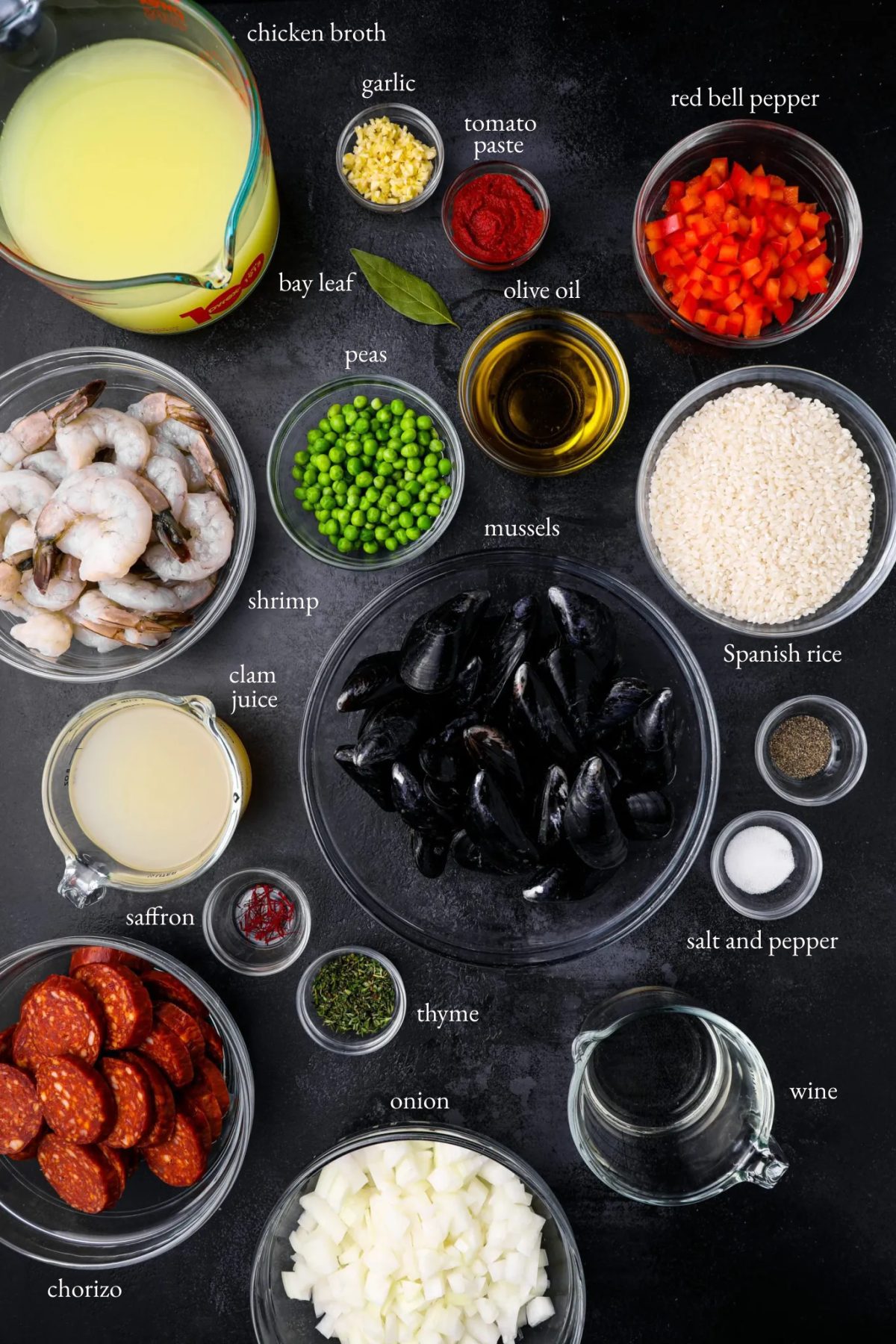
- Extra-virgin olive oil: Adds richness and helps to sauté the chorizo and vegetables.
- Smoked chorizo sausage: The meat element of the dish, it adds a smoky, spicy depth of flavor and a bit of fat. Typically located near the hot dogs and bacon in the supermarket, it is already fully cooked (it is not necessary to remove the casings).
- Onion, red bell pepper, garlic: The vegetable base that provides sweetness and aromatics.
- Tomato paste: Adds richness and a slight tanginess to the paella.
- Bomba rice: The key ingredient in paella, this short-grain rice is prized for its ability to absorb three times its volume in broth (rather than the normal two times) while still remaining firm. You can find it in many grocery stores or order it online.
- Chicken broth: The savory liquid base for cooking the rice.
- Bottled clam juice: Enhances the seafood essence of the paella.
- Saffron: Impart a distinctive golden color and aromatic flavor that is quintessential to paella. Saffron threads should be crushed before they are added to recipes to release their flavor. Simply use your thumb and forefinger to crush the threads into fine pieces.
- Frozen peas: Add a pop of color and sweetness.
- Large shrimp: A key seafood element of the dish.
- White wine (for cooking the mussels): Used to steam the mussels, the wine adds a subtle acidity and complexity to the dish.
- Mussels: Another seafood element, they bring a briny flavor to the dish. When you purchase mussels, they’re still alive. After bringing them home from the store, they will stay fresh in the refrigerator for several days. Because they’re alive, avoid storing them in an airtight container. Instead, place them in a bowl covered with a wet paper towel.
- Jump to the printable recipe for precise measurements
Step-by-Step Instructions
In a 13-inch paella pan, large enameled cast-iron pan (like a Le Creuset), or a large skillet, heat 2 tablespoons of the oil over medium heat. Cook the sliced chorizo, turning once, until lightly browned and some of the fat has rendered, about 3 minutes.
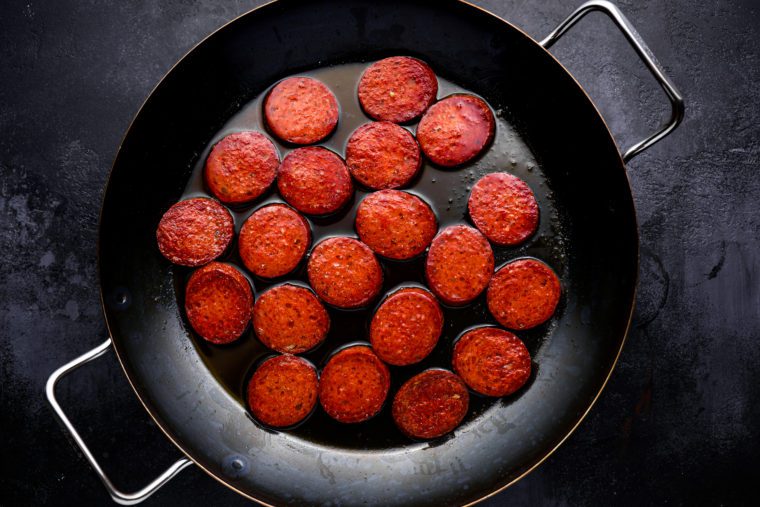
Using a slotted spoon, transfer the browned chorizo to a plate and set aside. Add the onion and bell pepper to the pan and cook over medium heat, stirring frequently, until softened, about 5 minutes. Add the garlic and cook 1 minute more. Stir in the tomato paste.
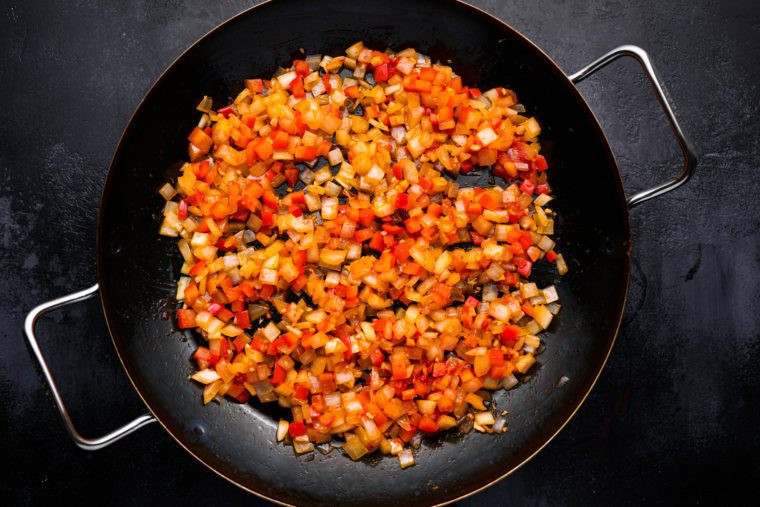
Add the rice and cook, stirring constantly, until coated with the vegetable mixture, about 2 minutes.
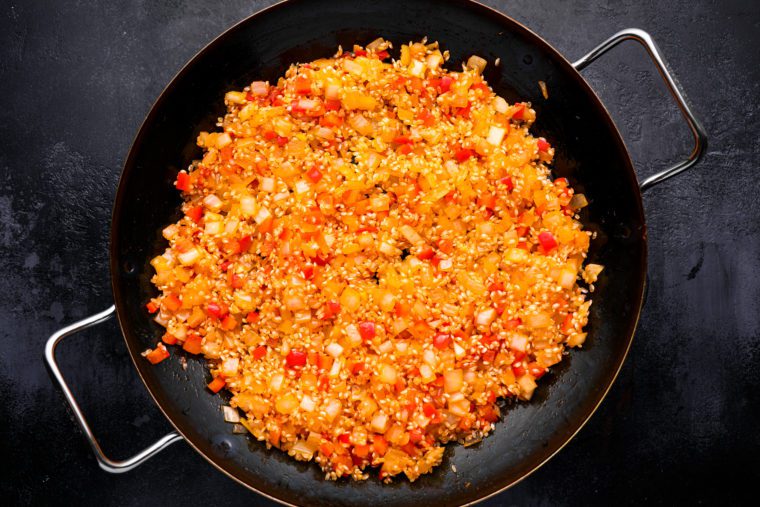
Add the broth, clam juice, saffron, bay leaf, ¾ teaspoon salt and ¼ teaspoon pepper; bring to a boil.
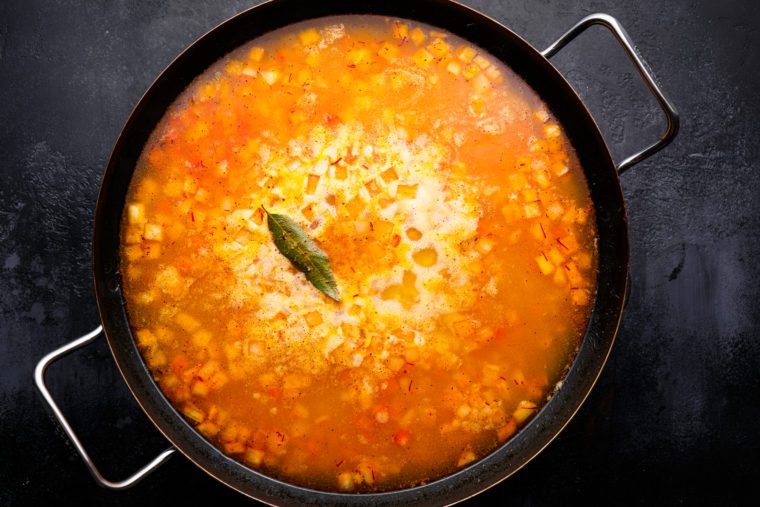
Cover and simmer over low heat, without stirring, until the rice is cooked and most of the liquid is absorbed, about 15 minutes. Fish out and discard the bay leaf. Stir in the peas, browned chorizo (along with any juices that accumulated on the plate) and thyme, then taste and adjust seasoning, if necessary. Remove the pan from the heat and cover to keep warm.
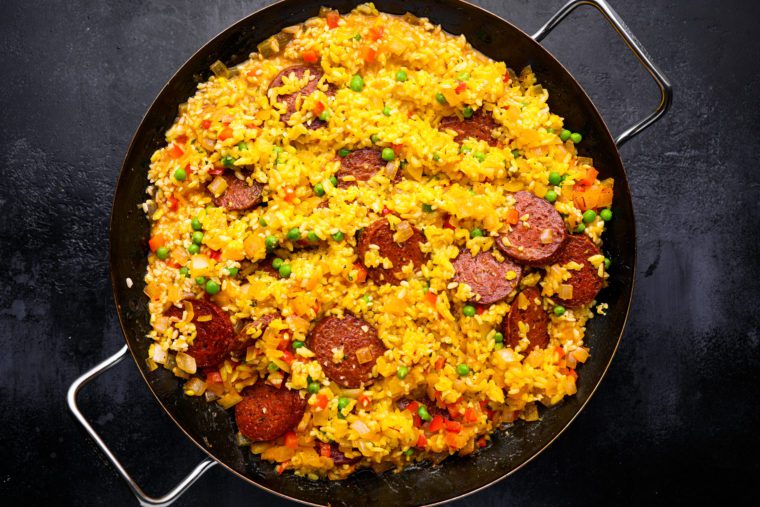
In a separate large skillet, heat 2 tablespoons of the oil over medium heat until shimmering. Add the shrimp and sprinkle with ¼ teaspoon salt and a few grinds of pepper; cook, turning once, until the shrimp are pink and cooked through, about 3 minutes.
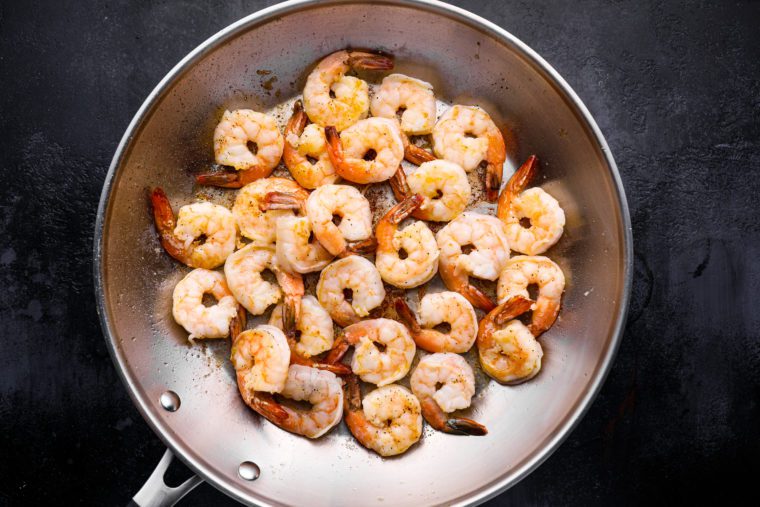
Add the shrimp to the paella and cover to keep warm.
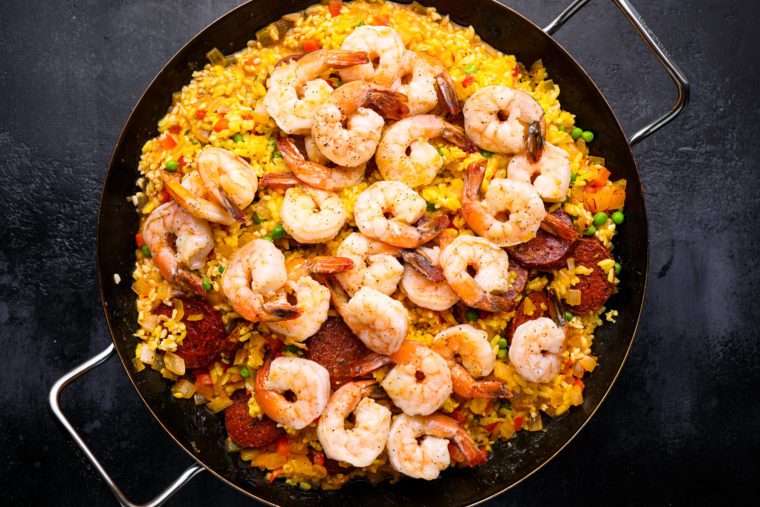
In the same skillet that you cooked the shrimp (no need to rinse it first), bring the wine to a boil over medium heat. Add the mussels and cover with a lid.
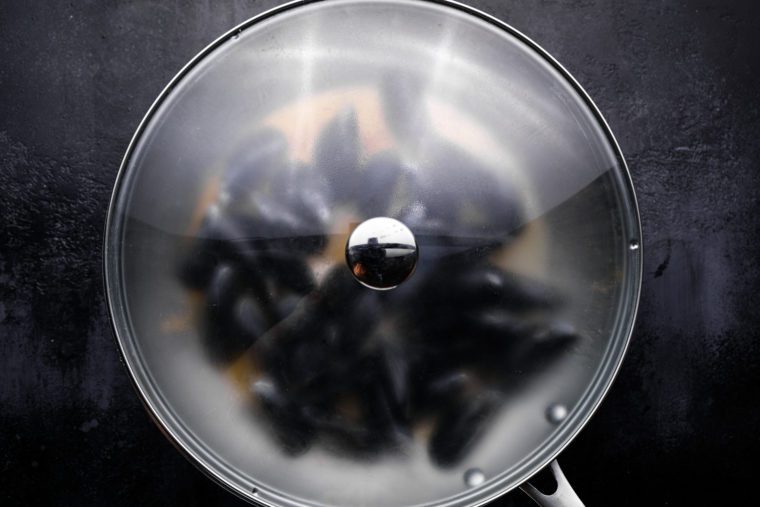
Cook, shaking the skillet occasionally, until the mussels open, 2 to 4 minutes.
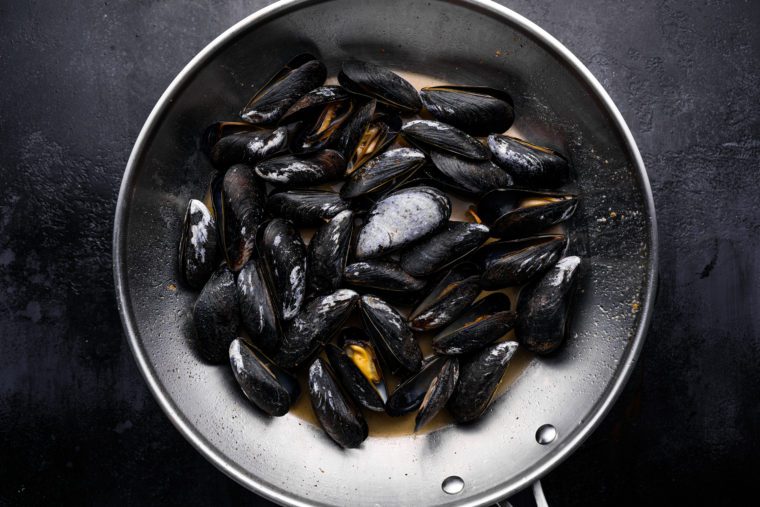
Pour the mussels and their cooking liquid over the paella. Drizzle the remaining 1 tablespoon of oil over the paella and serve.
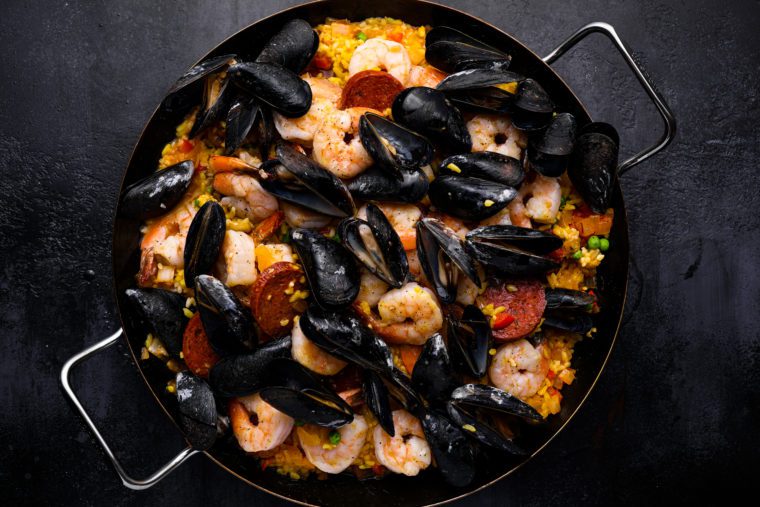
Frequently Asked Questions
Saffron comes from the stigmas of the Crocus sativus flower and is grown in regions with a Mediterranean climate, such as Iran, Spain, India, and Greece. It is renowned for its unmistakable aroma, subtle earthy flavor, and the rich golden-yellow color it lends to dishes. Because it is harvested by hand, saffron is the most expensive spice in the world. Usually, it is sold in small quantities, and it should be used sparingly—too much saffron will give food a medicinal taste. Store any leftover saffron for up to 6 months wrapped in foil and placed in an airtight container in a cool, dark place.
Absolutely! Paella is a versatile dish that can accommodate a variety of meats. Chicken, pork, or duck would all be nice additions. To easily incorporate them into this particular recipe, cook these meats beforehand and add them at the end before serving.
No, to enjoy paella at its best, it should be cooked fresh and served immediately. Preparing paella ahead of time and reheating it can result in overcooked rice and a loss of the vibrant, fresh taste that makes paella special.
The socarrat, or crispy layer of rice that forms on the bottom of the pan, is considered a delicacy in paella and adds a rich, toasted flavor. To achieve the socarrat, after the rice is cooked and the peas, chorizo, and thyme are mixed in, uncover the pan and increase the heat to medium-high for a few minutes. Watch closely and listen for the rice to crackle, indicating the formation of socarrat. Be careful to avoid burning. Once you achieve the desired crispness, remove the pan from heat and continue with the recipe by adding the cooked shrimp and mussels as directed.
Video Tutorial
You May Also Like
Spanish Paella
Paella is a classic Spanish rice dish that combines the best of land and sea. This version, packed with smoky chorizo, shrimp, and mussels, is easier to make than you’d think—and will rival your favorite Spanish restaurant’s version!
Ingredients
- 5 tablespoons extra-virgin olive oil
- 12 ounces smoked chorizo, sliced ½-inch thick on the bias (see note)
- 1 medium yellow onion, finely chopped
- 1 small red bell pepper, finely diced
- 3 large cloves garlic, finely chopped
- 1 tablespoon tomato paste
- 1½ cups Bomba rice or other Spanish paella rice (see note)
- 3½ cups chicken broth
- 1 cup bottled clam juice
- Generous pinch saffron threads, about ⅛ teaspoon crumbled (see note)
- 1 bay leaf
- Salt
- Freshly ground pepper
- ½ cup frozen peas, thawed
- 1 tablespoon chopped fresh thyme
- 1 pound large (31/35) shrimp, peeled and deveined
- ⅓ cup white wine
- 1 pound mussels, scrubbed and debearded (see note)
Instructions
- In a 13-inch paella pan, large enameled cast-iron pan (like a Le Creuset), or a large skillet, heat 2 tablespoons of the oil over medium heat. Cook the sliced chorizo, flipping once, until lightly browned and some of the fat has rendered, about 3 minutes. Using a slotted spoon, transfer the browned chorizo to a plate and set aside. Add the onion and bell pepper to the pan and cook, stirring frequently, until softened, about 5 minutes. Add the garlic and cook 1 minute more. Stir in the tomato paste.
- Add the rice and cook, stirring constantly, until coated with the vegetable mixture, about 2 minutes. Add the broth, clam juice, saffron, bay leaf, ¾ teaspoon salt and ¼ teaspoon pepper; bring to a boil. Cover and simmer over low heat, without stirring, until the rice is cooked and most of the liquid is absorbed, about 15 minutes. Discard the bay leaf. Stir in the peas, then the chorizo (along with any accumulated juices) and thyme; taste and adjust seasoning, if necessary. Remove the pan from the heat and cover.
- In a separate large skillet, heat 2 tablespoons of the oil over medium heat until shimmering. Add the shrimp and sprinkle with ¼ teaspoon salt and a few grinds of pepper; cook, turning once, until the shrimp are pink and cooked through, about 3 minutes. Add the shrimp to the paella and cover to keep warm.
- In the same skillet that you cooked the shrimp (no need to rinse it first), bring the wine to a boil over medium heat. Add the mussels and cover with a lid; cook, shaking the skillet occasionally, until the mussels open, 2 to 4 minutes. Pour the mussels and their cooking liquid over the paella.
- Drizzle the remaining 1 tablespoon of oil over the paella and serve.
- Note: Smoked chorizo is usually located near the hot dogs and bacon in the supermarket. It is already fully cooked, and it is not necessary to remove the casings.
- Note: Bomba or Spanish paella rice, a short-grain rice prized for its ability to absorb three times its volume in broth (rather than the normal two times) while still remaining firm, can be found in many grocery stores or you can order it online.
- Note: Saffron is harvested by hand, making it the most expensive spice in the world. Usually, it is sold in small quantities, and you only need a pinch. Saffron threads should be crushed before they are added to recipes to release their flavor. Simply use your thumb and forefinger to crush the threads into fine pieces. Be sure to use only the amount that the recipe calls for; too much saffron can give food a medicinal taste. Store any leftover saffron for up to 6 months wrapped in foil and placed in an airtight container in a cool, dark place.
- Note: When you purchase mussels, they're still alive. After bringing them home from the store, they will stay fresh in the refrigerator for several days. Because they're alive, avoid storing them in an airtight container. Instead, place them in a bowl covered with a wet paper towel. To clean mussels prior to cooking, put them in a colander and run them under cold running water. Use your hands or a scrubbing brush to remove any sand or remaining debris. If beards (the little tuft of fibers the mussel uses to connect to rocks or pilings) are present, cut or scrape them off with a paring knife, or use your fingers to pull them sharply down toward the hinged point of the shells. The mussels should be tightly closed. If you see a mussel that is open, tap it gently against the counter; in a live mussel, this will trigger a reaction to close its shell. If the mussel doesn't slowly close, it has died and should be discarded. Discard any mussels with cracked shells as well.
Nutrition Information
Powered by ![]()
- Per serving (6 servings)
- Calories: 763
- Fat: 37 g
- Saturated fat: 11 g
- Carbohydrates: 54 g
- Sugar: 5 g
- Fiber: 2 g
- Protein: 48 g
- Sodium: 1494 mg
- Cholesterol: 197 mg
This website is written and produced for informational purposes only. I am not a certified nutritionist and the nutritional data on this site has not been evaluated or approved by a nutritionist or the Food and Drug Administration. Nutritional information is offered as a courtesy and should not be construed as a guarantee. The data is calculated through an online nutritional calculator, Edamam.com. Although I do my best to provide accurate nutritional information, these figures should be considered estimates only. Varying factors such as product types or brands purchased, natural fluctuations in fresh produce, and the way ingredients are processed change the effective nutritional information in any given recipe. Furthermore, different online calculators provide different results depending on their own nutrition fact sources and algorithms. To obtain the most accurate nutritional information in a given recipe, you should calculate the nutritional information with the actual ingredients used in your recipe, using your preferred nutrition calculator.

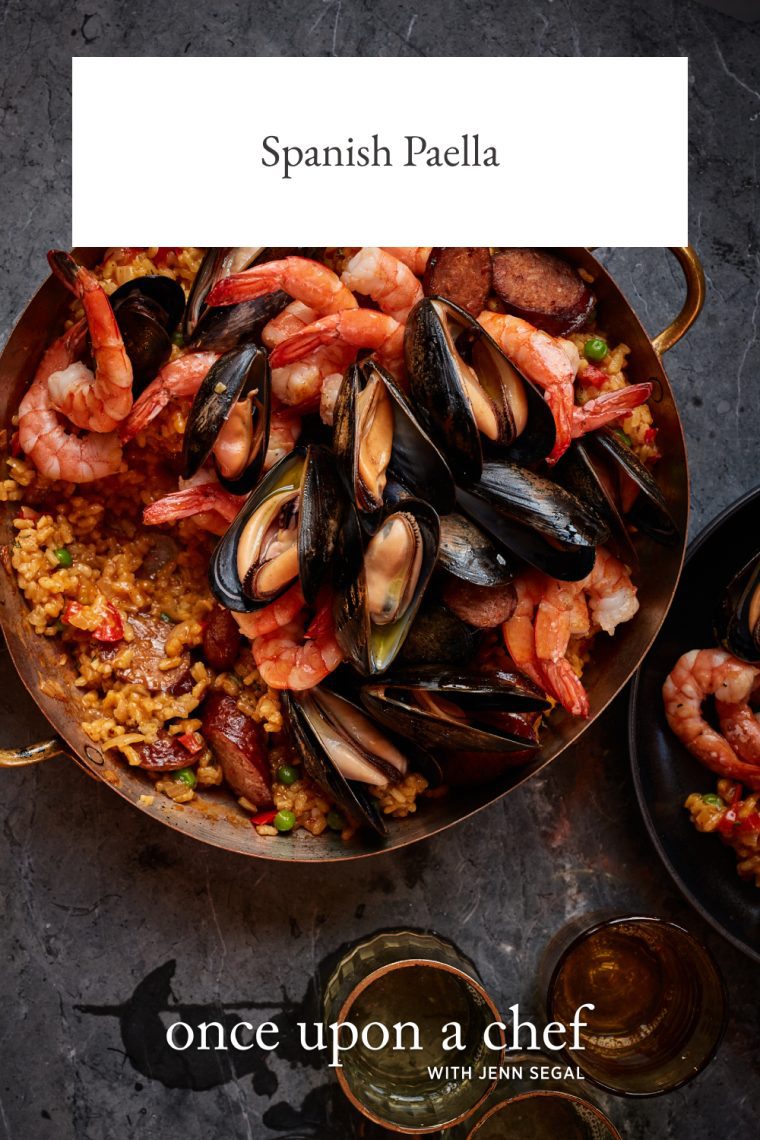
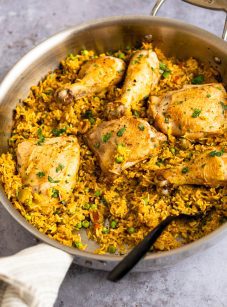
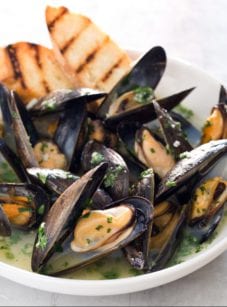
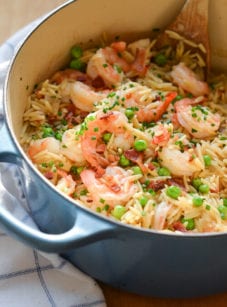
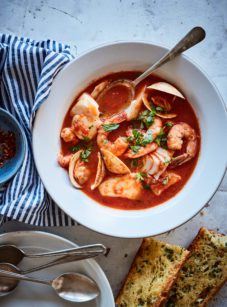
Hello Jenn!
Thanks for being ever so present in our kitchen for many years now😊. I would like to make this dish today and am having a hard time finding the Bomba rice. What rice substitute would you recommend? Your recipes are the best!
Hi Donna, If you’d prefer not to order Bomba rice online, medium-grain Spanish rice or arborio rice will work. Really any rice will work here; it may just have a mushier texture. Hope that helps and that you enjoy!
Good simple recipe but after 50 years of making Paella I prefer parboiled rice (Uncle Ben’s or other parboiled) to short grained rice.
Hi Jenn, would like to make this recipe for the holidays but would like to replace the mussels with scallops. How many scallops and when would I add them . I think I’m afraid of working with the mussels.. Thanks in advance.
Hi Arlene, I’d recommend 1/2 to 3/4 pound of scallops. I’d cook them separately and add them in at the end. Hope you enjoy!
Hi Jenn,
This looks amazing! Couple of questions if you don’t mind…
1. What do you think about using beef sausage (soujouk) instead of chorizo?
2. Can I use iron cast with a loose lid? If not, Dutch oven maybe?
Thanks so much for your help!
Hi Oleda, I think you could use the beef sausage but from what I read, it’s uncooked, so you’ll need to cook it first (chorizo is already cooked). And either of your pans will work. Hope you enjoy!
Hi Jenn,
I used beef sausage and cooked it. I went with cast iron with a loose lid and it worked. It was absolutely delicious and the presentation was beautiful. I just got back from Barcelona where I attended a paella cooking class by professional chefs. Although it was amazing, it took hours and too much work. Shrimp had heads that you needed press to squeeze the corral into the pan (not to mention hard to peel to eat afterwards 🤦♀️). They used squid and seafood broth. No mussels or meat (there are many versions though). They gave us the recipe but I will stick with yours – still my favorite by far! 😊
Hi Jenn! I enjoy your recipes and website. I am considering making your paella (minus the mussels) for a dinner party and would like to make the dish ahead of time. Do you have any suggestions for doing this? Thank you!
Hi Christine, I’ve never done it, but I think you could get away with preparing the paella up to the point right before you cook the shrimp. Hope everyone enjoys!
This is paella within reach—and it’s fantastic. My husband, 20-year-old son, and teenage daughter all raved. I wanted to make it right away, so I used Arborio rice instead of Bomba (but will order Bomba), and beef smoked sausage in place of chorizo because we don’t eat pork. Both worked perfectly. It is totally weeknight-dinner possible, and would be great for a small dinner party.
What can i substitute for clam juice? Thanks
Hi Rochelle, You can use chicken broth.
If I wanted to add chicken to this recipe, how would you suggest I prepare it and when should it be added?
Hi Lizrosie, I would roast 4 chicken drumsticks in the oven and then add them at the end. You can keep the seasoning simple with olive oil, salt, pepper, and paprika, and roast at 400°F for about 40 min. Please LMK how it turns out!
I am absolutely going to make this. But, I’ve got a couple questions first.
Why not cook the shrimp in with the rice, broth, vegetables, clam juice and garlic. Wouldn’t that add to the flavor of the Paella? Or could you cook the shrimp and mussels in the broth and then add the rice and veggies? Just a little curious. You may have very good reasons to do it this way.
I do make a lot of your recipes and think you have a great website!!!
Hi Janet, I prefer to cook the shrimp and mussels separately as it gives me more control over the cooking time and prevents overcooking. Since the cooking liquid from the mussels is added to the paella, you still get all that wonderful flavor. Hope that clarifies!
Hi Jenn, what can I use instead of chorizo?
Hi Carol, are you looking to avoid pork?
Hi Jenn! I did not ask the original question about the chorizo but I am also looking to avoid pork so if you have any similarly flavorful suggestions, I would appreciate it!
I would look for smoked chicken sausage, which you can find in the same section of the supermarket as the chorizo. Paella is very flexible, so it should work very well. Please LMK how it turns out!
Instead of chorizo I prefer hot italian sausages boiled for about 10 minutes then cut into slices before browning. I have bought Spanish chorizo but prefer these. I got the idea from an old cookbook (Table for 8 by Judith Huxley). She ran a column in WAPO in the 70s.
A flat bottom wok with a lid is what we use,it works well for this.Thx for the inspiration this looks delicious,quite sure it will be.
I made this as a recipe tester for Jenn’s 2nd cookbook and have made it twice again. It was a hit every time I made it and my son loved it. His approval was well received as he spent 2 1/2 years in Valencia and learned to make paella from a paella restaurant owner in exchange for English lessons.
Hi Jenn,
What, if anything, can be substituted for Mussels? I imagine this is delicious as your other recipes but I’m not a fan of them. Thank you!
Hi Cindy, You can replace with more shrimp or chorizo or add chicken.
Hi Jenn…if I skip the mussels do I need to replace the liquid with something else? Thank you! Ellyn
Hi Ellyn, the wine that the mussels cook in adds nice flavor, but if you’re not cooking them, you don’t need to replace it with any other liquid. Hope you enjoy!